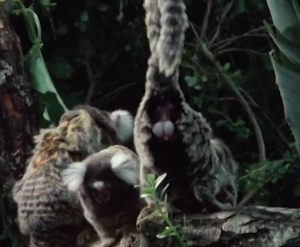Scientific name: Callithrix jacchus
Conservation status:
Life expectancy: 12 years in the wild
Gestation period: 148 days
x
Lifestyle and Location:
- This new world monkey has been introduced into and live in cities of Rio de Janeiro and Buenos Aires. However they are mainly found in forest habitats in South America.
- Their diet is mainly plants and insects. They also feed on gum, sap, latex and resin. To get these they use their claws to cling onto the tree while their teeth chew a hole in the bark of the tree.
Appearance:
These little monkeys weigh only 256 grams if they’re male and 236 grams if they are female. They are also only 18.8cm tall if they’re male and just a little smaller with 18.5 cm if they are female. They have a coat that is mixed with brown, grey and yellow, the tail is striped and white ear tufts.
Joss‘s Facts
- If they are scared they will flatten their tufts against their head and if they feel threatened or angry they will do a frown-like face.
- They are very active primates and start their day about 30 minutes after sunrise and won’t stop until around 30 minutes before sunset.
- Their tails are not prehensile, like all marmosets (This means they can not use their tail to hold onto branches)
- They have also been seen to screech to warn off enemies of their own kind and if that doesn’t work they will turn around and expose their backsides (as shown in the photo below). The trespassing marmosets nearly always flee at this point.

